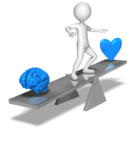 A recurring theme this week has been the interplay between the cultural and the technical dimensions of system improvement.
A recurring theme this week has been the interplay between the cultural and the technical dimensions of system improvement.
The hearts and the minds. The people and the process. The psychology and the physics.
Reflecting on the many conversations what became clear was that both are required but not always in the same amount and in the same sequence.
The context is critical.
In some cases we can start with some technical stuff. Some flow physics and a Gantt and Run chart or two.
In other cases we have to start with some cultural stuff. Some conversations about values, beliefs and behaviours.
And they are both tricky but in different ways.
The technical stuff is counter-intuitive. We have to engage our logical, rational thinking brains and work it through step-by-step, making every assumption explicit and every definition clear.
If we go with our gut we get it wrong (although we feel it is right) and then we fail, and then we blame others or ourselves. Either way we lose confidence. The logical thinking is hard work. It makes our heads ache. So we cut corners.
But once we have understood then it gets much easier because we can then translate our hard won understanding into a trusted heuristic. We do not need to work it out every time. We can just look up the correct recipe.
And there lurks a trap … the problem that was at first unrecognised, then impossible, then difficult, and then doable … becomes easy and even obvious … but only after we have worked out a solution. And that obvious-in-hindsight effect is a source of many dangers …
… we can become complacent, over-confident, and even dismissive of others who have not been through the ‘pain’ of learning. We may be tempted to elevate our status and to inflate our importance by hoarding our hard-won understanding. We risk losing our humility … and when we do that we stop being curious and we stop learning. And then we are part of the problem again.
So to avoid those traps we need to hold ourselves in the role of the teacher and coach. We need to actively share what we have learned and explain how we came to know it. One step at a time … the blood, the sweat and the tears … the confusion and eureka moments. Not one giant leap from where we started to where we got to. And when we have the generosity to share our knowledge … it is surprising how much we learn! We learn more from teaching than by being taught.
The cultural stuff is counter-intuitive too. We have to engage our emotional, irrational, feeling brains and step back from the objective fine-print to look at the subjective full-picture. We have to become curious. We have to look at the problem from as many perspectives as we can. We have to practice humble inquiry by asking others what they see.
If we go with our gut and rely only on our learned and habitual beliefs, our untested assumptions and our prejudices … we get it wrong. When we filter reality to match our rhetoric, we leap to invalid conclusions, and we make unwise decisions, and they lead to counter-productive actions.
Our language and behaviour gives the game away … we cannot help it … because all this is happening unconsciously and out of our awareness.
So we need to solicit unfiltered feedback from trusted others who will describe what they see. And that is tough to do.
So how do we know where to act first? Cultural or technical?
The conclusion I have come to is to use a check-list … the Safe System Improvement check-list so to speak.
Check cultural first – Is there a need to do some people stuff? If so then do it.
Check technical second – Is there a need to do some process stuff? If so then do it.
If neither are needed then we need to get out of the way and let the people redesign the processes. Only they can.
